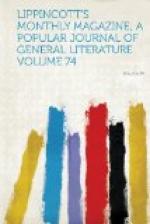the triple identity was jealously kept, until a vexatious
tangle of their names, and a claim from certain publishers
that the three authors of the three books were one
person and that all the novels were by the author of
“Jane Eyre,” roused Charlotte and Anne
Bronte to the point of setting off for London to show
Smith and Elder that they were honest and fair.
Up to this time the publishers had not known whether
they were women or men. “On reaching Mr.
Smith’s,” writes Mrs. Gaskell, “Charlotte
put his own letter into his hands,—the
same letter which had excited so much disturbance at
Haworth Parsonage only twenty-four hours before.
‘Where did you get this?’ said he, as
if he could not believe that the two young ladies dressed
in black, of slight figures, looking pleased yet agitated,
could be the embodied Currer and Acton Bell for whom
curiosity had been hunting so eagerly in vain.”
The secret, however, was not disclosed, except to the
publishers. Until “Shirley” was published,
opinion was much divided as to the probable sex of
Currer Bell, but “Shirley” was declared
to be written by a woman; and, this suggestion once
started, questions of identity soon settled themselves.
Charlotte went to London again, and this time was
introduced to all the literary people in the town.
It was not until her third visit, however, that she
attended a lecture of Thackeray’s, and at the
close found that the audience, instead of withdrawing,
had formed themselves into two lines and drawn back
to see the famous authoress as she passed out.
“During this passage through the ‘cream
of society,’ Miss Bronte’s hand trembled
to such a degree that her companion feared lest she
should turn faint and be unable to proceed.”
Ellis and Acton Bell were in their early graves, and
all the splendor of her fame could hardly lighten
by a breath the weight of that lonely sorrow of Charlotte.
The story of George Eliot’s pseudonyme has been
too recently told to require allusion, except to point
out its practical value to herself, shielding as it
did her susceptibilities,—in fact, guarding
like a chrysalis the first strivings, the flutter
into full life, of that immortal winged thing it concealed.
Several of our own female writers have chosen a masculine
nom de plume, and guarded it consistently,
like Saxe Holm, etc. Miss Murfree is, we
believe, the first whose disguise editors as well as
the general public failed to pierce. Now that
the critical faculty begins to play more surely upon
the works of Charles Egbert Craddock, it may be said
that a woman’s love of romance and picturesqueness
shades off into haze and unreality some of the pictures
of life which a man’s experience and surer knowledge
would have made vivid by fewer and more vigorous strokes.
However, as long as she chose, Miss Murfree held her
secret beyond the reach of discovery, because nobody
questioned it; her disclosure was piquant, and the
state of surprise into which she threw her admirers
was so utter that the full story of it ought to be
told, although we are not empowered to tell it here.




